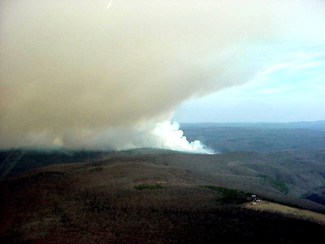A reader sent in this link to an EESI report.Here’s a link, and below is an excerpt.
In a similar story in its June 27 edition, the Los Angeles Times reported on an interview with forestry expert Peter Fule of Northern Arizona University. “Firefighting technology has meant fewer fires. Fuel to feed massive blazes has built up. And, Fulé said, climate change has brought warming conditions over the last couple of decades — meaning longer fire seasons, starting early in the spring and extending late into the fall. Even if rain and snow mounts
remain the same, he said, warmer temperatures mean more evaporation, drying out the landscape. Individual drought years increase the risk of huge fires.”Better forest management could help prevent and reduce such conflagrations in the future and make forests healthier and more resilient in the face of a changing climate. But federal and state forest management budgets are already stretched too thin. Steven Running says: “The single biggest factor is keeping forests thinned out, and dead trees removed. I really wish we had a forest bio-energy industry to use all this forest biomass and pay for the work by buying the material.”
The U.S. Forest Service (USFS) Four Forests Restoration Initiative in central Arizona may provide a model for intergovernmental and public/private partnerships to help restore forest health and reduce the risk of intensely destructive wildfires. This multi-year project is one of ten demonstration projects in the federal Collaborative Forest Landscape Restoration Program. According to the USFS web site, “The overall goal of the four-forest effort is to create landscape-scale restoration approaches that will provide for fuels reduction, forest health, and wildlife and plant diversity. A key objective is doing this while creating sustainable ecosystems in the long term. Appropriately-scaled businesses will likely play a key role in the effort by harvesting, processing, and selling wood products. This will reduce treatment costs and provide restoration-based work opportunities that will create good jobs.”
Another example of collaborative ecosystem management is occurring in the Flathead National Forest in Montana. This project is also supported through the federal Collaborative Forest Landscape Restoration Program. See this recent news story from the Missoulian on how diverse stakeholders came together to develop and implement this landscape management plan.
Forest fuel reduction activities have already generated positive results in terms of reducing the intensity of wildfires and protecting property. See this recent report from USFS, How Fuel Treatments Saved Homes from the 2011 Wallow Fire in Arizona. Will forest thinning and fuel reduction increase greenhouse gas emissions? Research has
shown that forest fuel reduction efforts can result in a net reduction in greenhouse gas emissions and provide other environmental benefits compared to business as usual (namely unmanaged, over-stocked forests with intense wildfires) when the woody materials that are removed are used for building materials, other wood products, and bioenergy. See for
example the October/November 2011 special edition of the Journal of Forestry, entitled “Managing Forests Because Carbon Matters: Integrating Energy, Products, and Land Management Policy”. Section 2 on “Forest Carbon Stocks and Flows” surveys the recent literature on carbon accounting for various forest management approaches.More, intense, highly destructive forest fires need not be the future of the American west. The federal government has a critical role to play both in managing its forests better and in building successful collaborations among diverse stakeholders on the ground to help restore resilient and healthy ecosystems across public and private lands. Allowing and encouraging the development of local biomass energy markets can be an important part of this. By creating economic value for fuel reduction and restoration activities, more forest acreage can be treated and scarce public dollars can be conserved for other purposes. This could be a win-win for public safety, public lands, climate change mitigation and adaptation, ecosystem health, local economies, and local and regional energy security.
Congress could help. In addition to sustaining investments in public and private forest health initiatives, reauthorizing and funding the Forest Biomass for Energy Program (which would provide competitive grants for research and development on the use of low-value forest biomass for energy, among other priorities) and the Community Wood Energy
Program (which would provide grants to state and local governments to develop community wood energy plans and systems) would be a step in the right direction. The House version of the Farm Bill (see Title IX in this summary), which is scheduled to be marked up by the Committee on Agriculture July 11, would repeal the Forest Biomass for Energy Program and reduce funding for the Community Wood Energy Program from $5 million per year to $2 million per year.
So who is EESI? Do they have an axe to grind (so to speak ;))? They don’t appear to be any of the usual suspects…here’s the Board of Directors. Here are their funders.
Here’s a link to their forest initiative.


